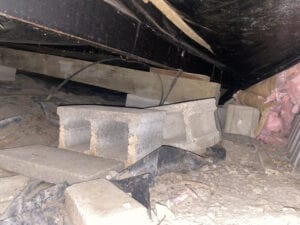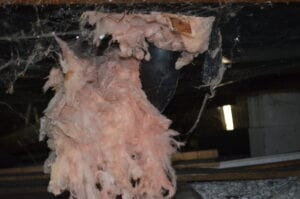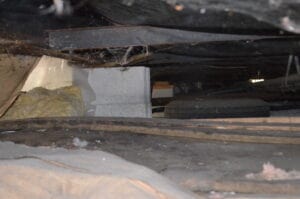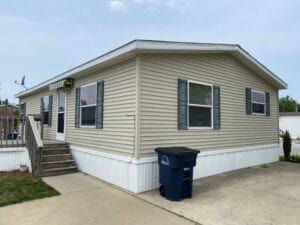If you live in a mobile home, you know how important it is to have proper insulation. Insulation under a mobile home can help keep your home warm in the winter and cool in the summer. It can also help reduce your energy bills by preventing heat loss or gain.
Insulation Under a Mobile Home
One of the main benefits of insulation under a mobile home is that it can help prevent moisture buildup. Moisture can lead to mold and mildew growth, which can be harmful to your health. Insulation can also help prevent pests from entering your home through the floor. Additionally, it can help reduce noise and make your home more comfortable.

Why Is Insulation Under a Mobile Home Important
Insulating your mobile home is essential for many reasons. Here are a few reasons why it’s important to insulate under your mobile home:
Energy Efficiency
Insulating under your mobile home helps to maintain a comfortable temperature inside your home. It helps to keep the heat in during the winter and the cool air in during the summer. This means that your HVAC system won’t have to work as hard to maintain a comfortable temperature, which can save you money on your energy bills.
You might also be interested in our article The Average Electric Bill For a Mobile Home.
Moisture Control
Insulation also helps to control moisture levels under your mobile home. Without proper insulation, moisture can build up, leading to mold and mildew growth. This can cause health problems for you and your family, as well as damage to your home.
Do you have moisture under your mobile home read our article Crawl Space Encapsulation.
Pest Control
Insulation can also help to keep pests out of your home. Without proper insulation, pests like rodents and insects can easily make their way into your home. Insulation can help to keep them out, protecting your home and your family.
Read our article Rodents and Pests Under Your Mobile Home.

Structural Integrity
Insulation also helps to protect the structural integrity of your home. Without proper insulation, the subfloor can become damaged over time due to moisture and pests. This can lead to costly repairs down the line.
Overall, insulating under your mobile home is an important step in protecting your home and keeping it comfortable for you and your family.
Underbelly Insulation
Underbelly insulation is an essential component of mobile home insulation. It is the insulation that is installed between the bottom of the mobile home and the ground. The underbelly insulation helps to keep the home warm in the winter and cool in the summer. It also helps to prevent moisture from entering the home, which can cause damage to the structure.
Insulation Under a Mobile Home: Different Types
There are several types of underbelly insulation available, including fiberglass batts, spray foam, and rigid foam boards. Fiberglass batts are the most common type of insulation used for underbelly insulation. They are easy to install and relatively inexpensive. However, they are not as effective as other types of insulation at preventing moisture from entering the home.
SPRAY FOAM INSULATION
Spray foam insulation is another option for underbelly insulation. It is more expensive than fiberglass batts, but it is also more effective at preventing moisture from entering the home. Spray foam insulation is also more durable than fiberglass batts and can last longer.
RIGID FOAM BOARD INSULATION
Rigid foam boards are another option for underbelly insulation. They are the most expensive option, but they are also the most effective at preventing moisture from entering the home. Rigid foam boards are also very durable and can last a long time.
When choosing underbelly insulation, it is important to consider the climate in your area. If you live in a cold climate, you may want to choose a more effective insulation, such as spray foam or rigid foam boards. If you live in a warmer climate, fiberglass batts may be sufficient.
In addition to choosing the right type of insulation, it is also important to ensure that the insulation is installed properly. The insulation should be installed tightly and securely to prevent air leaks. It should also be installed with a vapor barrier to prevent moisture from entering the home.
Overall, underbelly insulation is an important component of mobile home insulation. It helps to keep the home warm in the winter, cool in the summer, and prevents moisture from entering the home. When choosing underbelly insulation, it is important to consider the climate in your area and choose the right type of insulation for your needs.

Should You Insulate Your Crawl Space Walls?
Insulating your crawl space walls can provide several benefits, including improved energy efficiency, increased comfort, and reduced moisture levels. However, before you decide to insulate your crawl space walls, there are some factors you should consider.
First, you should assess the current state of your crawl space. If your crawl space is damp or prone to flooding, insulating the walls may not be the best solution. In fact, insulation can exacerbate moisture issues, leading to mold growth and other problems. In this case, it may be more beneficial to address the moisture issue before considering insulation.
Read our article Water Leak Under a Mobile Home.
Climate: Crawl Space Insulation
Second, you should consider the climate in your area. If you live in a region with mild temperatures, insulating your crawl space walls may not be necessary. However, if you live in an area with extreme temperatures, insulation can help regulate the temperature in your home and reduce energy costs.
Third, you should consider the type of insulation you want to use. There are several types of insulation available, including batts, blown-in, and spray foam. Each type has its own advantages and disadvantages, so it’s important to do your research and choose the best option for your specific needs.
In summary, insulating your crawl space walls can provide several benefits, but it’s important to assess the current state of your crawl space, consider the climate in your area, and choose the best type of insulation for your needs before making a decision.
Best Insulation to Use Under the Home?
When it comes to insulating underneath your mobile home, there are several options available. The best insulation to use will depend on your specific needs and budget. Here are some of the most popular options:
Fiberglass Batt Insulation
Fiberglass batt insulation is a popular choice for insulating underneath mobile homes. It is affordable, easy to install, and readily available at most home improvement stores. Fiberglass batts come in standard sizes that can be cut to fit the space between your mobile home’s floor joists. They are also available with a vapor barrier to help prevent moisture buildup.
Spray Foam Insulation
Spray foam insulation is another popular option for insulating underneath mobile homes. It is more expensive than fiberglass batts, but it provides better insulation and helps to seal air leaks. Spray foam insulation is applied as a liquid and expands to fill the space between your mobile home’s floor joists. It can also be used to fill gaps and cracks in your home’s foundation.
Rigid Foam Insulation
Rigid foam insulation is a more expensive option, but it provides excellent insulation and is easy to install. It comes in large panels that can be cut to fit the space between your mobile home’s floor joists. Rigid foam insulation is also available with a vapor barrier to help prevent moisture buildup.
Reflective Insulation
Reflective insulation is a lightweight, affordable option for insulating underneath mobile homes. It consists of a layer of aluminum foil that reflects heat and a layer of bubble wrap that provides insulation. Reflective insulation is easy to install and can be cut to fit the space between your mobile home’s floor joists.
In conclusion, the best insulation to use under your mobile home will depend on your specific needs and budget. Fiberglass batt insulation is affordable and easy to install, while spray foam insulation provides better insulation and helps to seal air leaks. Rigid foam insulation is a more expensive option, but it provides excellent insulation and is easy to install. Reflective insulation is a lightweight, affordable option that is easy to install. Choose the insulation that best fits your needs and budget to ensure your mobile home stays warm in the winter and cool in the summer.

How to Repair Insulation That Is Damaged?
If you have noticed that the insulation under your mobile home has been damaged, it is important to repair it as soon as possible to prevent further damage. Here are the steps to follow to repair damaged insulation under your mobile home:
Identify the damaged areas: The first step is to identify the areas where the insulation is damaged. Look for areas that are wet, moldy, or have been chewed by rodents.
Remove the damaged insulation: Once you have identified the damaged areas, remove the damaged insulation carefully. Wear gloves and a mask to protect yourself from mold and dust.
Clean the area: After removing the damaged insulation, clean the area thoroughly. Use a vacuum cleaner to remove any dust or debris.
Replace the insulation: Cut a new piece of insulation to fit the area where the damaged insulation was removed. Use a staple gun to secure the insulation in place.
Seal the area: Finally, seal the area with a sealant to prevent moisture from entering. This will also help to keep rodents out.
By following these steps, you can repair damaged insulation under your mobile home and prevent further damage. It is important to regularly inspect your insulation to ensure that it is in good condition and replace any damaged insulation as soon as possible.
Spray Foam: Pros and Cons
If you are considering insulation options for your mobile home, spray foam might be a good choice. Here are some pros and cons to help you decide if it is right for you:
Pros: Spray Foam Insulation
Excellent insulation: Spray foam has a high R-value, meaning it provides a lot of insulation per inch of thickness. This can help keep your home warm in the winter and cool in the summer.
Air sealing: Spray foam can also seal gaps and cracks in your home’s underbelly, preventing air leaks that can waste energy and make your home less comfortable.
Moisture protection: Closed-cell spray foam is impermeable to water vapor, which can help protect your home from moisture damage and mold growth.
Long lifespan: When properly installed, spray foam can last for decades without needing to be replaced.
Cons: Spray Foam Insulation
Cost: Spray foam can be more expensive than other insulation options, especially if you hire a professional to install it.
Installation difficulty: Spray foam can be tricky to install correctly, and mistakes can lead to problems down the line.
Potential health risks: Spray foam can release harmful chemicals during installation, so it is important to use proper protective equipment and ventilation.
Difficult to remove: If you ever need to remove spray foam insulation, it can be difficult and messy to do so.
Overall, spray foam can be a good choice for mobile home insulation if you are willing to invest in a quality installation and take the necessary precautions. However, it may not be the best choice for everyone, so be sure to weigh the pros and cons carefully before making a decision.
Insulation Under a Mobile Home: Cost
When it comes to insulating under your mobile home, the cost can vary depending on a few factors. Some of these factors include the size of your mobile home, the type of insulation you choose, and whether you hire a professional or do it yourself.
If you choose to hire a professional, the cost can range from $1,500 to $3,000. This cost includes the insulation materials and the labor to install it. However, if you choose to do it yourself, you can save a significant amount of money. The cost of insulation materials can range from $500 to $1,000, depending on the type of insulation you choose.
There are a few different types of insulation you can use under your mobile home. One option is fiberglass insulation, which is a popular choice due to its affordability. Another option is spray foam insulation, which is more expensive but provides better insulation. Additionally, you can consider using reflective insulation, which is a good choice if you live in a hot climate.
It’s important to note that while insulating under your mobile home can be an upfront cost, it can also save you money in the long run. Insulation can help keep your home warm in the winter and cool in the summer, which can reduce your energy bills. Additionally, insulation can help prevent moisture buildup, which can lead to mold and other issues.
Overall, the cost to insulate under your mobile home can vary depending on your specific situation. However, it’s important to consider the long-term benefits of insulation and how it can save you money in the future.
Insulation Foam Board Under Mobile Home?
If you’re considering insulating your mobile home, you may be wondering if insulation foam board is a good option. The answer is yes, insulation foam board can be an effective choice for insulating the underside of your mobile home.
Insulation foam board is a type of rigid insulation that is made from polystyrene or polyurethane foam. It is lightweight, easy to install, and has a high R-value, which means it can provide excellent insulation against heat loss or gain.
When installing insulation foam board under your mobile home, it’s important to choose the right thickness. The thickness you need will depend on the climate in your area and the type of heating and cooling system you have in your mobile home. Generally, a thickness of 2 inches is recommended for moderate climates, while a thickness of 3 inches or more may be needed for colder climates.
To install insulation foam board under your mobile home, you’ll need to first clean the underside of your home and make sure it is free of debris. Then, measure and cut the foam board to fit between the floor joists. You can use a construction adhesive to attach the foam board to the underside of your home.
One benefit of using insulation foam board is that it can also help to reduce noise and vibration from outside sources, such as traffic or nearby construction. Additionally, it can help to prevent moisture from entering your home, which can lead to mold and mildew growth.
Overall, insulation foam board can be a great option for insulating the underside of your mobile home. It is affordable, easy to install, and can provide excellent insulation and other benefits.
Insulation Under a Mobile Home: Blanket for Mobile Home
When it comes to insulating your mobile home, one option to consider is an insulation blanket. These blankets are typically made from fiberglass or mineral wool and come in rolls that can be cut to fit the dimensions of your mobile home.
Installing an insulation blanket can help to keep your mobile home warm in the winter and cool in the summer. It can also help to reduce your energy bills by improving the efficiency of your heating and cooling systems.
To install an insulation blanket, you will need to measure the dimensions of your mobile home and purchase the appropriate amount of insulation. You will also need to gather some basic tools, such as a utility knife, a staple gun, and a ladder.
Before installing the insulation, it is important to make sure that your mobile home is properly sealed. This means sealing any gaps or cracks around windows, doors, and other areas where air can escape. Once your mobile home is properly sealed, you can begin installing the insulation blanket.
To install the insulation, simply roll out the insulation blanket and cut it to fit the dimensions of your mobile home. Then, staple the insulation to the underside of your mobile home. Be sure to wear gloves and a mask to protect yourself from any fiberglass or mineral wool fibers.
Overall, an insulation blanket can be a cost-effective and efficient way to insulate your mobile home. By properly sealing your mobile home and installing an insulation blanket, you can help to keep your home comfortable and reduce your energy bills.
Insulation Under a Mobile Home: Conclusion
In conclusion having insulation under your mobile home can save you hundreds on your energy bill. Whether you need to install all new insulation or just fix what you have its worth doing. Hopefully this article Insulation Under Your Mobile Home helped you decide how to install insulation under your home.
FAQ’s: Under a Mobile Home Insulation
Do I need a vapor barrier under my mobile home?
Yes, it is generally advisable to install a vapor barrier under your mobile home. A vapor barrier can help prevent moisture from rising from the ground and causing issues like mold and rot in your home.
How do you fix the underbelly of a mobile home?
Repairing the underbelly of a mobile home typically involves removing damaged insulation and materials, addressing any issues, and then resealing and re-insulating the underbelly. It’s essential to consult with a professional or follow manufacturer guidelines for specific instructions.
What is the best insulation for trailer walls?
The best insulation for trailer walls depends on factors like your climate and budget. Common options include fiberglass, foam board, or spray foam insulation. The choice should consider your specific needs and the R-value required for your region.
Can you spray insulation in a mobile home?
Yes, you can use spray foam insulation in a mobile home. It can be an effective option for sealing gaps and providing good insulation, but it’s important to follow safety guidelines and hire a professional for the installation.
